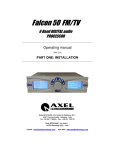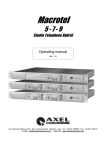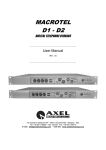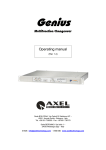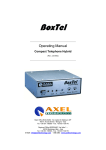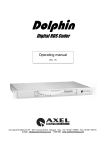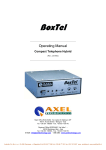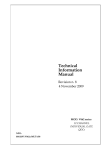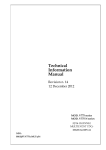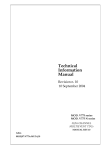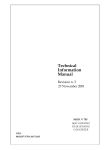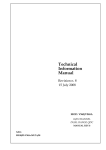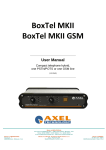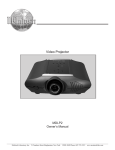Download Falcon 50 FM
Transcript
Falcon 50 FM 6 Band DIGITAL audio PROCESSOR Operating manual (Rel. 1.3) PART ONE: INSTALLATION Via Caduti Di Sabbiuno 6/F - 40011 Anzola Emilia - Bologna - Italy Tel. +39 051 736555 – 051 736154 - Fax. +39 051 736170 e-mail: [email protected] - web site: www.axeltechnology.com Pag. 2 FOREWORD ENG 1 FOREWORD From all of us at Axel Technology, thank you for choosing the Falcon 50 FM digital audio processor. A great deal of effort went into the design and construction of this precision device. With proper installation and calibration the processor will give you the most accurate results for audio processing and modulation. Take the time to go through the steps provided in this manual to ensure you get the most out of your equipment. Used properly, the Falcon 50 will give you many years of enjoyment. Measurements of the Falcon 50 yield excellent results by any standards. However, the Falcon 50 audio quality can not always be represented only by measures. We therefore invite You to a complete and enjoyable listening session... Pag. 3 ENG For your own safety and to avoid invalidation of the warranty all text marked with these Warning Symbols should be read carefully. Information in this manual is subject to change without notice and does not represent a commitment on the part of the vendor. Axel Technology shall not be liable for any loss or damage whatsoever arising from the use of information or any error contained in this manual, or through any mis-operation or fault in hardware contained in the product. It is recommended that all maintenance and service on the product should be carried out by Axel Technology or its authorised agents. Axel Technology cannot accept any liability whatsoever for any loss or damage caused by service, maintenance or repair by unauthorised personnel. Pag. 4 TABLE OF CONTENTS ENG 2 TABLE OF CONTENTS 1 2 3 FOREWORD......................................................................................................................................... 3 TABLE OF CONTENTS........................................................................................................................ 5 INTRODUCTION................................................................................................................................... 6 3.1 APPROACHING AN FM AUDIO PROCESSOR..........................................................................................8 14.1 14.2 14.3 14.4 14.5 POWER SUPPLY CABLE .........................................................................................................................24 AC MAINS VOLTAGE SETTING (230 V / 115 V) .....................................................................................24 FUSE REPLACEMENT .............................................................................................................................25 PROTECTION AGAINST LIGHTNING ....................................................................................................25 VENTILATION .........................................................................................................................................26 4 5 6 7 8 9 10 11 12 13 14 INSTALLATION CONSIDERATIONS ................................................................................................... 9 BLOCK DIAGRAM ............................................................................................................................. 10 SAFETY WARNINGS ......................................................................................................................... 11 FOREWORD....................................................................................................................................... 12 SAFETY WARNINGS ......................................................................................................................... 13 CONSIGNES DE SÉCURITÉ IMPORTANTES.................................................................................... 15 ISTRUZIONI IMPORTANTI PER LA SICUREZZA........................................................................... 17 WICHTIGE SICHERHEITSHINWEISE............................................................................................. 19 INSTRUCCIONES IMPORTANTES DE SEGURIDAD ..................................................................... 21 UNPACKING AND INSPECTION .................................................................................................... 23 FIRST INSTALLATION RECOMMENDATIONS .............................................................................. 24 15 AUDIO AND MPX GENERAL SETTINGS ....................................................................................... 27 16 GENERAL DESCRIPTION .............................................................................................................. 30 17 AUDIO I/O WIRING ......................................................................................................................... 33 15.1 AUDIO INPUT IMPEDANCE....................................................................................................................27 15.2 MPX OUTPUT SETTINGS ........................................................................................................................28 16.1 REAR PANEL VIEW .................................................................................................................................30 16.2 FRONT PANEL SOCKETS AND SIGNALLINGS .....................................................................................32 17.1 17.2 17.3 17.4 ANALOG AUDIO INPUT..........................................................................................................................33 ANALOG AUDIO OUTPUT ......................................................................................................................33 AUDIO CABLING.....................................................................................................................................34 DIGITAL AUDIO INPUT...........................................................................................................................34 10.2.1 Converting between AES/EBU and S/PDIF interfaces..........................................................................34 17.5 DIGITAL AUDIO OUTPUT.......................................................................................................................34 17.6 DIGITAL AUDIO SYNCHRONIZATION INTERFACE............................................................................35 18 COMMUNICATION PORTS, AUDIO JACK AND GPI/O WIRING .................................................... 36 18.1 SERIAL PORT ...........................................................................................................................................36 18.2 USB PORTS...............................................................................................................................................37 10.2.1 18.3 18.4 18.5 18.6 18.7 19 INSTALLING USB DRIVERS ..............................................................................................................37 ETHERNET PORT*...................................................................................................................................39 GP INPUT INTERFACE ............................................................................................................................40 GP OUTPUT INTERFACE.........................................................................................................................42 FRONT HEADPHONE SOCKET...............................................................................................................43 MPX AND AUX CONNECTIONS .............................................................................................................44 INSTALLING THE REMOTE CONTROL SOFTWARE .................................................................... 45 Pag. 5 INTRODUCTION 3 ENG INTRODUCTION Congratulations on your purchase of the Falcon 50 FM. The Axel Technology design team is confident you will enjoy the outstanding performance of the DAP for many years. In case you are interested in technical details, what follows is a brief outline of some of the key technologies in your new processor. A brief overview Relying on Axel Technology’s extensive know-how in audio processing techniques, the Falcon 50 FM has been designed and built using a new approach that incorporates the most up-to-date components and technologies. Its efficient design allows the Falcon 50 to produce top-level results in a cost-effective way. The largest control set allows you to paint a truly unique and competitive on-air sound: from detailed and flat to heavy and loud. Its exceptional audio quality is maintained even at extreme settings. The largest connection capabilities Whether your audio system contains analog, digital or both formats, the Falcon 50 FM can be configured to fit in perfectly. A sophisticated module allows flexible switching between inputs, e.g. for emergency purpose. Fail-safe operation is assured by an internal bypass on all the audio and MPX I/O circuits. Two Composite Baseband Outputs are provided, each with independent level control. The MPX clipping stage is user-enable and adjustable. MPX power can be limited accordingly to ITU R-BS 412 Specification. Two serial RS232 ports, an USB port and a TCP/IP Ethernet connection (the latter available as an option) permit remote control and monitoring from almost any location through the use of a standard PC and the dedicated control software which comes with the unit. User-friendly controls Falcon 50 FM set-up is quick and easy, thanks to a wizard based on less/more controls. User-configurable remote control functions (including preset programming) are available through optocoupled inputs. For more convenience, a complete day-part automation is also completely self-contained. Control from anywhere The Falcon 50 can be remotely controlled, either from a locally attached computer, or from anywhere in the world. There are many ways to do this. - Using Falcon 50’s IP connection or modem connection you can control processor from any where in the world using the provided remote Control Software. - Falcon 50’s serial and USB interfaces allow you to connect any PC running the provided remote Control Software. - Falcon50’s programmable TTL inputs give you six “contact closure” inputs that can be used to control certain functions, like ‘switch audio input’ or ‘change audio curve’. State-of-art circuitation and plenty of headroom Falcon 50’s analog and digital audio input and output circuits are state-of-the-art for high quality, low noise and low distortion audio. The processor’s levels on analog input assure plenty of headroom for all applications without the need for audio limiters. Professional quality AES/EBU digital audio input and output, with internal high-quality rate converters are standard. Pag. 6 INTRODUCTION ENG Built-in automatic audio changeover The Falcon 50 features two inputs: analog and digital. The selection between inputs may be achieved manually or the programme source may be forced to either input Analog or input Digital by activating one of six GP Input, accordingly to Source Selection menu. The Falcon 50 also incoporates an audio detector stage, which can be used to automatically select between two identical stereo programme paths (Analog or Digital), in the event the main program runs underthreshold (set at – 35 dB), extinguishes or the difference on levels between Left and Right channels exceeds 20 dB. Once the Falcon 50 has switched from Main to Stand-by input, the Main input may be kept monitored till the Main audio input resumes. Also when Main audio appears, a settable time may be awaited before inverse switching (from B to A) is performed. OPTIONAL FEATURES DESCRIPTION TCP –IP The TCP IP interface allows users to view/take control of Falcon 50 from any Windows machine networked with the processor. NOTE: the present manual describes the processor in its complete configuration. Depending on the chosen configuration and on the chosen options, Yr actual equipment might not provide some of the here-below described features or controls. Pag. 7 INTRODUCTION 3.1 ENG APPROACHING AN FM AUDIO PROCESSOR An audio processor is a nonlinear process, that is, even if the ouput signal might be slightly more attractive in respect to the input signal, it has surely more distortion respect to the input. For this reason, always try to use the cleanest possible audio material to get the cleanest ouput audio and remember that the correct adjustment of a multiband processor is a quite complicated task, so, don’t be frustrated if after thirty minutes you still cannot get your sound. Remember also that “extreme loudness” settings are well suited only for certain kinds of music (pop, disco, rap…) while are awful for other kinds of music; so always adapt the processor to the format of your radio. General settings often sound well with most music formats even if they have not the same loudness. The output sound is always a trade-off between loudness distortion and cleaness and you must choose the trade-off between them according your taste. Another last tip is that you might avoid the use of high stereo expander levels expecially with low bitrate MP3s; MPEG compression puts a lot of “trash” into the stereo image so, often, enhancing the stereo image you could enhance just “MPEG noise” (a sort of “tingling” you may hear at medium-high frequencies). Last recommendation is to use a good quality audio board with a “flat” output, that is no further bass or treble equalization must be added. This is the only way you may expect to have a good peak control and a satisfactory audio quality. Pag. 8 INSTALLATION CONSIDERATIONS ENG 4 INSTALLATION CONSIDERATIONS Installing the Falcon 50 requires a bit more than mounting it in the rack, connecting some cables, and then putting it on the air. Among the factors you should consider are: 1. Monitor Location. You should have a good location in which the system, once on the air, can be monitored. We suggest a good tuner, with good reception, feeding a set of studio monitor speakers to be sufficient. While car radio and other “typical listener situation” settings are important, they should not be the main reference points. 2. Good, Clean Source Material. If you are using poor source material, or poor performing playback equipment, you will not get maximum sonic benefit from your equipment. Anomalies that you perceive to be processing problems, may be source problems that the processing is exaggerating! Make sure that you start out with a good first step - good source material! 3. Mic Processing. This may appear trivial, but the perceived sound of “live” voices over the air can change dramatically with different processing systems. Whatever the effect your on-air microphones will probably change when you change your processing. If you utilize mic processing, you may have to adjust it to suit the operation of the new processing system. Most announcers develop a “comfort zone” with respect to the sound of their voice over the air. When that “comfort zone” is changed or modified, the common response is that something is wrong. Mic processing can be a very important part of your overall station sound. 4. Operating Levels. This is another simple area where trouble can develop. Make sure the input and output levels of the processor are at the operating at the proper level within your system. If you are comparing the Falcon 50 with other processors, be sure they are operating at the same levels. Your modulation monitor is an important tool in any processing comparison. Equipment internal Clock is powered by a capacitor instead of a traditional battery. The capacitor keeps the clock operating and protects the system memory to prevent the loss of stored programs during power failure around one week long (depending on the environmental conditions). Capacity charge needs at least 30’ of normal operation. Clock tolerance might amount to about 1 sec per day. A correct installation and an optimum level setting are crucial for a good operating and the exploitation of all the equipment capabilities. Please pay attention to all notes contained in the user manual. Pag. 9 ENG BLOCK DIAGRAM 5 BLOCK DIAGRAM Block diagram D I G I I TN A L Digital Input 32,44.1,48,96 KHz Hi-Pass 30Hz Input mode switch Phase Rotator Input External Signals A N A I L ON G Analog Input 47.5Ks/sec User Command Hi-Pass 30Hz Input mode switch 2-Band AGC Primary Input Selector Selection Command Logic EQ Stereo Enhancer Mode Phase Rotator Freq. Modulation AD Clipping Point D A B I BO OU C T D I GO I U T T A L A NO AU L OT G H E A DO P HU OT N E S MO PU X T 1 MO PU X T 2 A U I XN 1 A U I XN 2 OPTIONAL Input EQ Multiband FM-Proc DAB/IBOC FM-Proc Input FM-Proc Generator Input FM-Proc Generator Monitor Input 6-Band FM-Proc Monitor 6-Band 5-Band 6-Band L I M I T E R E X P A N D E R C O M P R E S S O R Look Ahead Limiter & Expander Super Bass MPX Power Limiter Opto Interface FM-Proc Generator Input 1° 2° 3° 4° 5° 6° 1° 2° 3° 4° A U I XN 3 Pag. 10 SAFETY WARNINGS ENG 6 SAFETY WARNINGS SAFETY WARNINGS CONSIGNES DE SÉCURITÉ IMPORTANTES ISTRUZIONI IMPORTANTI PER LA SICUREZZA WICHTIGE SICHERHEITSHINWEISE INSTRUCCIONES IMPORTANTES DE SEGURIDAD (Rel. 1.0) Pag. 11 FOREWORD ENG 7 FOREWORD For your own safety and to avoid invalidation of the warranty all text marked with these Warning Symbols should be read carefully. Information in this manual is subject to change without notice and does not represent a commitment on the part of the vendor. The manufacturer shall not be liable for any loss or damage whatsoever arising from the use of information or any error contained in this manual, or through any mis-operation or fault in hardware contained in the product. It is recommended that all maintenance and service on the product should be carried out by the manufacturer or its authorised agents. The manufacturer cannot accept any liability whatsoever for any loss or damage caused by service, maintenance or repair by unauthorised personnel. Pag. 12 SAFETY WARNINGS ENG 8 SAFETY WARNINGS The installation and servicing instructions in this manual are for use by qualified personnel only. - Read All Instructions. All safety and operating instructions must be read before operating the product. They also must be retained for future reference, as it contains a number of useful hints for determining the best combination of equipment settings for Yr particular application. - Heed All Warnings. All warnings on the product and those listed in the operating instructions must be adhered to. - Heat. This product must be situated away from any heat sources such as radiators or other products (including power amplifiers or transmitters) that produce heat. - Power Sources. This product must be operated from the type of power source indicated on the marking label and in the installation instructions. If you are not sure of the type of power supplied to your facility, consult your local power company. Make sure the AC main voltage corresponds to that indicated in the technical specifications. If a different voltage (ex. 110/115 VAC) is available, open the equipment closure and set the voltage switch on the main supply circuit, located behind the AC socket - Power Cord Protection. Power supply cords must be routed so that they are not likely to be walked on nor pinched by items placed upon or against them. Pay particular attention to the cords at AC wall plugs and convenience receptacles, and at the point where the cord plugs into the product - Clean only with dry cloth - Use only with a cart, stand, tripod, bracket, or table specified by the manufacturer, or sold with the apparatus. When a cart is used, use caution when moving the cart/apparatus combination to avoid injury from tip-over. - Lightning. For added protection for this product during a lightning storm, or when it is left unattended and unused for long periods of time, unplug it from the AC wall outlet and the audio connections. This will prevent damage to the product due to lightning and power line surges - Installation. Configuration and installation should only be carried out by a competent installation engineer - Cabling. Using high quality wires, well protected. Make sure the cable integrity. - Equipment design. This manual images could differ a bit from the equipment actual design This symbol alerts you to the presence of dangerous voltage inside the closure – voltage which may be sufficient to constitute a risk of shock. Do not perform any servicing other than that contained in the operating instructions. Refer all servicing to qualified personnel The exclamation point within an equilateral triangle is intended to alert the user to the presence of important operating and maintenance (servicing) instructions in the literature accompanying the appliance. Pag. 13 SAFETY WARNINGS ENG Do not change the voltage setting or replace the mains fuse without first turning the unit off and unplugging the mains cord. This apparatus must be EARTHED ! To avoid risk of fire use the correct value fuse, as indicated on the label stuck on the right side of the unit. Make sure the AC main voltage corresponds to that indicated in the technical specifications. This apparatus uses a single pole mains switch and does therefore not separate the unit completely from the mains power. To completely separate from mains power (f.i. in the event of danger) unplug mains power cord. As the MAINS plug as the disconnect device, the disconnect device shall remain readily operable. Pag. 14 CONSIGNES DE SÉCURITÉ IMPORTANTES 9 ENG CONSIGNES DE SÉCURITÉ IMPORTANTES - Lire ces consignes - Conserver ces consignes - Observer tous les avertissements - Suivre toutes les consignes - Ne pas utiliser cet appareil à proximité de l’eau - Nettoyer uniquement avec un chiffon sec - Ne pas obstruer les ouvertures de ventilation. Installer en respectant les consignes du fabricant - Ne pas installer à proximité d'une source de chaleur telle qu'un radiateur, une bouche de chaleur, un poêle ou d'autres appareils (dont les amplificateurs) produisant de la chaleur. - Ne pas annuler la sécurité de la fiche de terre, la troisième branche est destinée à la sécurité. Si la fiche fournie ne s'adapte pas à la prise électrique, demander à un électricien de remplacer la prise hors normes. - Protéger le cordon d'alimentation afin que personne ne marche dessus et que rien ne le pince, en particulier aux fiches, aux prises de courant et au point de sortie de l’appareil - Utiliser uniquement les accessoires spécifiés par le fabricant - Utiliser uniquement avec un chariot, un support ou une table spécifié par le fabricant ou vendu avec l’appareil. Si un chariot est utilisé, déplacer l’ensemble chariot–appareil avec précaution afin de ne pas le renverser, ce qui pourrait entraîner des blessures - Débrancher l’appareil pendant les orages ou quand il ne sera pas utilisé pendant longtemps. - Confier toute réparation à du personnel qualifié. Des réparations sont nécessaires si l’appareil est endommagé d’une façon quelconque, par exemple: cordon ou prise d’alimentation endommagé, liquide renversé ou objet tombé à l’intérieur de l’appareil, exposition de l’appareil à la pluie ou à l’humidité, appareil qui ne marche pas normalement ou que l’on a fait tomber. - NE PAS exposer cet appareil aux égouttures et aux éclaboussements. Ne pas poser des objets contenant de l'eau, comme des vases, sur l'appareil Ce symbole indique la présence d'une tension dangereuse dans l'appareil constituant un risque de choc électrique. Ce symbole indique que la documentation fournie avec l'appareil contient des instructions d'utilisation et d'entretien importantes. Pag. 15 CONSIGNES DE SÉCURITÉ IMPORTANTES ENG Avant de modifier le commutateur de changement de tension ou replacer le fusible il faut débrancher l’appareil de la prise électrique Pendant son usage, l’appareil doit etre branchee à la prise de terre Utiliser le fusible principal AC avec le valeur qui est indiquée sur l'étiquette collée sur le coffret. Assurez-vous que la tension principale AC correspond à celle indiquée dans les spécifications techniques. L’interrupteur d’alimentation interrompt un pôle du réseau d’alimentation excepté le conducteur de terre de protection. En cas de danger, debrancher le cordon d'alimentation. Parce que la prise du réseau de alimentation est utilisée comme dispositif de déconnexion, ce dispositif doit demeuré aisément accessible. Pag. 16 ISTRUZIONI IMPORTANTI PER LA SICUREZZA ENG 10 ISTRUZIONI IMPORTANTI PER LA SICUREZZA - Leggere le presenti istruzioni - Conservare queste istruzioni - Osservare tutte le avvertenze - Seguire scrupolosamente tutte le istruzioni - Non usare questo apparecchio in prossimità di acqua - Pulire l'apparecchio solo con un panno asciutto. - Non ostruire alcuna apertura per il raffreddamento. Installare l’apparecchio seguendo le istruzioni - Non installare l'apparecchio accanto a fonti di calore quali radiatori, aperture per l'afflusso di aria calda, forni o altri apparecchi (amplificatori inclusi) che generino calore - Non rimuovere il terminale di connessione a terra sul cordone di alimentazione: esso ha lo scopo di tutelare l’incolumità dell’utilizzatore. Se la spina in dotazione non si adatta alla presa di corrente, rivolgersi ad un elettricista per far eseguire le modifiche necessarie. - Evitare di calpestare il cavo di alimentazione o di comprimerlo, specialmente in corrispondenza della spina e del punto di inserzione sull’apparato. - Utilizzare solo dispositivi di collegamento e gli accessori specificati dal produttore. - Utilizzare l’apparecchio solo con un carrello, un sostegno, una staffa o un tavolo di tipo specificato dal produttore o venduto insieme all’apparecchio. Se si utilizza un carrello, fare attenzione negli spostamenti per evitare infortuni causati da ribaltamenti del carrello stesso - Scollegare l’apparecchio dalla presa di corrente durante i temporali o quando inutilizzato a lungo - Per qualsiasi intervento, rivolgersi a personale di assistenza qualificato. È’ necessario intervenire sull’apparecchio ogniqualvolta si verificano danneggiamenti di qualsiasi natura. Ad esempio, la spina o il cavo di alimentazione sono danneggiati, è entrato liquido nell’apparecchio o sono caduti oggetti su di esso, l’apparecchio è stato esposto alla pioggia o all’umidità, non funziona normalmente o è caduto. - Non esporre a sgocciolamenti o spruzzi. Non appoggiare sull'apparecchio oggetti pieni di liquidi, ad esempio vasi da fiori. Questo simbolo indica la presenza di alta tensione all'interno dell'apparecchio, che comporta rischi di scossa elettrica. Questo simbolo indica la presenza di istruzioni importanti per l'uso e la manutenzione nella documentazione in dotazione all'apparecchio. Pag. 17 ISTRUZIONI IMPORTANTI PER LA SICUREZZA ENG Non sostituire il fusibile o cambiare la tensione di alimentazione senza aver prima scollegato il cordone di alimentazione. L’apparato deve essere connesso a terra durante il suo utilizzo. Sostituire il fusibile generale con uno di identico valore, come indicato sulla etichetta applicata sul mobile dell’apparato. Assicurarsi che la tensione di rete corrisponda a quella per la quale è configurato l’apparecchio. Questo apparato utilizza un interruttore di alimentazione di tipo unipolare e l’isolamento dalla rete elettrica non è pertanto completo. Per ottenere un isolamento totale (ad esempio in caso di pericolo), scollegare il cordone di alimentazione. Inoltre, poichè la spina di alimentazione è utilizzata come dispositivo di sezionamento, essa deve restare facilmente raggiungibile. Pag. 18 WICHTIGE SICHERHEITSHINWEISE ENG 11 WICHTIGE SICHERHEITSHINWEISE - Diese Hinweise LESEN - Diese Hinweise AUFHEBEN - Alle Warnhinweise BEACHTEN - Alle Anweisungen BEFOLGEN - Dieses Gerät NICHT in der Nähe von Wasser verwenden - NUR mit einem sauberen Tuch REINIGEN - KEINE Lüftungsöffnungen verdecken. Gemäß den Anweisungen des Herstellers einbauen - Nicht in der Nähe von Wärmequellen, wie Heizkörpern, Raumheizungen, Herden oder anderen Geräten (einschließlich Verstärkern) installieren, die Wärme erzeugen - Die Schutzfunktion des Schukosteckers NICHT umgehen. Bei Steckern für die USA gibt es polarisierte Stecker, bei denen ein Leiter breiter als der andere ist; US-Stecker mit Erdung verfügen über einen dritten Schutzleiter. Bei diesen Steckerausführungen dient der breitere Leiter bzw. der Schutzleiter Ihrer Sicherheit. Wenn der mitgelieferte Stecker nicht in die Steckdose passt, einen Elektriker mit dem Austauschen der veralteten Steckdose beauftragen - VERHINDERN, dass das Netzkabel gequetscht oder darauf getreten wird, insbesondere im Bereich der Stecker, Netzsteckdosen und an der Austrittsstelle vom Gerät - NUR das vom Hersteller angegebene Zubehör und entsprechende Zusatzgeräte verwenden. - NUR in Verbindung mit einem vom Hersteller angegebenen oder mit dem Gerät verkauften Transportwagen, Stand, Stativ, Träger oder Tisch verwenden. Wenn ein Transportwagen verwendet wird, beim Verschieben der Transportwagen-Geräte- Einheit vorsichtig vorgehen, um Verletzungen durch Umkippen - Das Netzkabel dieses Geräts während Gewittern oder bei längeren Stillstandszeiten aus der Steckdose ABZIEHEN. - Alle Reparatur- und Wartungsarbeiten von qualifiziertem Kundendienstpersonal DURCHFÜHREN LASSEN. Kundendienst ist erforderlich, wenn das Gerät auf irgendwelche Weise beschädigt wurde, z.B. wenn das Netzkabel oder der Netzstecker beschädigt wurden, wenn Flüssigkeiten in das Gerät verschüttet wurden oder Fremdkörper hineinfielen, wenn das Gerät Regen oder Feuchtigkeit ausgesetzt war, nicht normal funktioniert oder fallen gelassen wurde. - Dieses Gerät vor Tropf- und Spritzwasser SCHÜTZEN. KEINE mit Wasser gefüllten Gegenstände wie zum Beispiel Vasen auf das Gerät STELLEN. Dieses Symbol zeigt an, dass gefährliche Spannungswerte, die ein Stromschlagrisiko darstellen, innerhalb dieses Geräts auftreten. Dieses Symbol zeigt an, dass das diesem Gerät beiliegende Handbuch wichtige Betriebs- und Wartungsanweisungen enthält. Pag. 19 WICHTIGE SICHERHEITSHINWEISE ENG Vor Änderung der Netzspannung oder Sicherungswechsel Netzkabel trennen. Das Gerät muss für den Betrieb geerdet werden. Hauptsicherung nur mit einer gleichwertigen austauschen (s. entsprechende Etikette). Vor Einschalten Netzspannungseinstellung am Gerät überprüfen bzw. anpassen. Inpoliger Netzschalter. In Notfälle oder für Wartungsarbeiten Netzkabel trennen. Der Netzstecker fungiert auch als Trennelement muss deshalb zugänglich bleiben Pag. 20 INSTRUCCIONES IMPORTANTES DE SEGURIDAD ENG 12 INSTRUCCIONES IMPORTANTES DE SEGURIDAD - LEA estas instrucciones - CONSERVE estas instrucciones - PRESTE ATENCION a todas las advertencias. - SIGA todas las instrucciones - NO utilice este aparato cerca del agua - LIMPIESE UNICAMENTE con un trapo seco - NO obstruya ninguna de las aberturas de ventilación. Instálese según lo indicado en las instrucciones del fabricante - No instale el aparato cerca de fuentes de calor tales como radiadores, registros de calefacción, estufas u otros aparatos (incluyendo amplificadores) que produzcan calor - NO anule la función de seguridad del enchufe polarizado o con clavija de puesta a tierra. Un enchufe polarizado tiene dos patas, una más ancha que la otra. Un enchufe con puesta a tierra tiene dos patas y una tercera clavija con puesta a tierra. La pata más ancha o la tercera clavija se proporciona para su seguridad. Si el toma corriente no es del tipo apropiado para el enchufe, consulte a un electricista para que sustituya el toma corriente de estilo anticuado - PROTEJA el cable eléctrico para evitar que personas lo pisen o estrujen, particularmente en sus enchufes, en los toma corrientes y en el punto en el cual sale del aparato - UTILICE únicamente los accesorios especificados por el fabricante - UTILICESE únicamente con un carro, pedestal, escuadra o mesa del tipo especificado por el fabricante o vendido con el aparato. Si se usa un carro, el mismo debe moverse con sumo cuidado para evitar que se vuelque con el aparato - DESENCHUFE el aparato durante las tormentas eléctricas, o si no va a ser utilizado por un lapso prolongado. - TODA reparación debe ser llevada a cabo por técnicos calificados. El aparato requiere reparación si ha sufrido cualquier tipo de daño, incluyendo los daños al cordón o enchufe eléctrico, si se derrama líquido sobre el aparato o si caen objetos en su interior, si ha sido expuesto a la lluvia o la humedad, si no funciona de modo normal, o si se ha caído. - NO exponga este aparato a chorros o salpicaduras de líquidos. NO coloque objetos llenos con líquido, tales como floreros, sobre el aparato . Este símbolo indica que la unidad contiene niveles de voltaje peligrosos que representan un riesgo de choques eléctricos. Este símbolo indica que la literatura que acompaña a esta unidad contiene instrucciones importantes de funcionamiento y mantenimiento. Pag. 21 INSTRUCCIONES IMPORTANTES DE SEGURIDAD ENG Antes de cambiar la alimentacion de voltaje o de cambiar el fusible, desconecte el cable de alimentacion. Para reducir el riesgo de descargas electricas, esta unidad debe ser conectada a tierra. Remplaze el fusible con lo mismo, que corresponde a lo indicado en el panel del equipo. Antes de encender, controlar que la linea de alimentacion de voltaje corresponda a la indicada. El interruptor de alimentación es unipolar. En el caso de peligro, desconecte el cable de alimentación. Porque la clavija de conexion a red sirve por la desconection de la unidad, la clavija debe ser ubicada en proximidad de la unidad. Pag. 22 UNPACKING AND INSPECTION ENG 13 UNPACKING AND INSPECTION Your equipment was packed carefully at the factory in a container designed to protect the unit during shipment. Nevertheless, we recommend making a careful inspection of the shipping carton and the contents for any signs of physical damage. Damage & Claims If damage is evident, do not discard the container or packing material. Contact your carrier immediately to file a claim for damages. Customarily, the carrier requires you, the consignee, to make all damage claims. It will be helpful to retain the shipping documents and the waybill number. Save all packing materials! If You should ever have to ship the unti (e.g. for servicing), it is best to ship it in the original carton with its packing materials because both the carton and packing material have been carefully designed to protect the unit. Under normal conditions no user maintenance or calibration are required. Internal links and preset controls may be set to configure the unit during installation. Any service work required should be carried out by qualified service personnel only. We are able to offer further product support through our worldwide network of approved dealers and service agents. To help us provide the most efficient service please would you keep a record of the unit serial number, and date and place of purchase to be quoted in any communication regarding this product. The actual equipment Serial Number is indicated on the silver label stuck on the rear panel of the equipment closure. Manufacturer Model : XXX 230V 115V S-N : KKKK VA mAT VA mAT Tools And Equipment Needed Only standard technician’s tools are required to install this equipment. Pag. 23 FIRST INSTALLATION RECOMMENDATIONS ENG 14 FIRST INSTALLATION RECOMMENDATIONS 14.1 POWER SUPPLY CABLE A power supply cable of approx. 2 m length is supplied with the device. The type of plug for the power supply depends on the country in which it is delivered. Supply cables should be laid in such a manner that one does not step or walk on them. They should not be squashed by any objects. THIS EQUIPMENT MUST BE EARTHED. The chassis is always connected to mains earth to ensure your safety: check your mains wiring and earthing before switching on. 14.2 AC MAINS VOLTAGE SETTING (230 V / 115 V) BE SURE THAT THE UNIT IS SET TO THE CORRECT MAINS/LINE VOLTAGE FOR YOUR COUNTRY BEFORE PLUGGING IT INTO THE WALL OUTLET ! The actual Mains voltage is indicated on the label stuck on the equipment closure. Should the type of power at the operation location not be known, please contact your dealer or electricity company. Manufacturer Model : XXX 230V 115V S-N : KKKK VA mAT VA mAT If, for some reason, the unit is to be operated at a mains input voltage which is different to that as supplied, you need to open the top cover and set properly the voltage change-over switch which is located inside, close to the transformer. You also need to replace the AC main fuse, according to information provided on the external label or on the Technical Specifications table at the end of this user manual. CAUTION: TO REDUCE THE RISK OF ELECTRICAL SHOCK, ALWAYS DISCONNECT THE AC MAINS CABLE BEFORE ALTERING THE CHANGE-OVER SWITCH. NO USER SERVICEABLE PARTS INSIDE. REFER SERVICING TO QUALIFIED SERVICE PERSONNEL. Pag. 24 FIRST INSTALLATION RECOMMENDATIONS ENG 14.3 FUSE REPLACEMENT The power supply socket has an integral fuse drawer containing the AC power fuse and a spare, both of the same value. BEFORE REPLACING THE POWER FUSE, MAKE SURE YOU HAVE THE RIGHT TYPE OF FUSE FOR THE VOLTAGE TO BE PROTECTED. USING WRONG FUSE TYPE WILL RESULT IN INSUFFICIENT PROTECTION. Make sure that the power is switched off and the power cable is disconnected from the equipment. Open the fuse drawer using a small blade screwdriver. Replace the fuse located at the inner position Push the fuse socket back into the original position Perform the set-up under static control conditions. Static charges are likely to completely destroy one or more of the CMOS semiconductors employed in the unit. Static damage will not be covered under warranty. Basic damage prevention consists of minimizing generation, discharging any accumulated static charge on your body and preventing that discharge from being sent to or through any electronic component. Uninsulated dangerous voltage are inside the enclosure, voltage that may be sufficient to constitute a risk of shock. Always disconnect to AC Mains before removing the top cover 14.4 PROTECTION AGAINST LIGHTNING Should the device be put out of action due to being struck by lightning or excess voltage, disconnect it from the power supply without delay. Do not reconnect until the device has been checked. If in doubt contact the technical support service. Make sure there is suitable lightning protection to protect the device. Alternatively you should disconnect all connectors from the device during a storm or when the device is going to be unsupervised or not used for a longer period of time. These measures will protect against damage by lightning or excess voltage. Pag. 25 ENG FIRST INSTALLATION RECOMMENDATIONS 14.5 VENTILATION The equipment will operate as a free-standing unit without requiring any special cooling arrangement. However, slots and openings in the product are provided for ventilation. They ensure reliable operation of the product, keeping it from overheating. These openings must not be blocked nor covered during operation. YOU MUST LEAVE AT A MINIMUM ONE RACK UNIT OF EMPTY SPACE ABOVE THE EQUIPMENT TO ENHANCE VENTILATION AND TO GET A LONGER EQUIPMENT LIFE. Pag. 26 AUDIO AND MPX GENERAL SETTINGS ENG 15 AUDIO AND MPX GENERAL SETTINGS 15.1 AUDIO INPUT IMPEDANCE The analog input impedance may be set to 600Ohm, rather than the default 10kOhm, by moving the two jumpers J4 and J5 placed at the back of input XLR connectors (see figure below). Pag. 27 AUDIO AND MPX GENERAL SETTINGS ENG 15.2 MPX OUTPUT SETTINGS The Falcon 50 is fitted with two MPX outputs with independent level adjustements and three Auxiliary inputs. The AUX input gains may be set to 0 dB (i.e. unity gain, DEFAULT setting) or to – 20 dB (1/10 gain) through the J1, J2 and J3 jumpers located just at the back of the respective Bnc connectors. Please note, the AUX 1 input allows to inject signals on the OUTPUT 1 only; the AUX 2 input allows to inject signals on the OUTPUT 2 only, while the AUX 3 input allows to inject signals on both outputs. Pag. 28 AUDIO AND MPX GENERAL SETTINGS M P X SyncOUT MPX Outputs ENG Aux Inputs Pag. 29 ENG GENERAL DESCRIPTION 16 GENERAL DESCRIPTION 16.1 REAR PANEL VIEW 17 I 16 I 15 I 14 I 13 I 12 I AES/EBU AES/EBU S/PDIF CAUTION RISK OF ELECTRIC SHOCK DO NOT OPEN R E M O T E C O N T R O L 1 Outputs Ethernet I 2 USB I 3 SyncOUT I 4 MPX Outputs I 5 I 6 I 7 I 8 Outputs I 9 R Outputs I 10 D I G I T A L Inputs 1 3 2 13 2 L Aux Inputs 231 13 2 SyncIN Inputs M P X Serial RS-232 I 1 23 1 G P S/PDIF 231 L 231 R Inputs A N A L O G I 11 ON/OFF Switch, AC MAINS FUSE AND AC POWER RECEPTACLE. main ON/OFF switch, the LED inside switches on/off accordingly. An AC mains fuse is provided which disconnects the Falcon 50 from the wall outlet’s AC power under fault conditions. If this fuse should “blow” for any reason, replace it only with the same value fuse. If it blows a second time, please contact your Axel Technology dealer for service. Two fuses (one for spare) are contained in a small drawer close to the cord receptacle. For 220/230 V AC the fuse is slo-blo 5x20mm rated at 315 mA T; for 110 V AC it is rated at 630 mA T This apparatus uses a single pole mains switch and does therefore not separate the unit completely from the mains power. To completely separate from mains power; unplug mains power cord. Never operate the Falcon 50 with ungrounded outlets: plugging the processor into an ungrounded outlet or defeating the ground pin, can create a potentially hazardous condition. Axel Technology can not be held responsible for problems caused to Falcon 50 or any associated equipment with improper AC connection. 2 RS232 Serial Port: This port is intended for the processor setting and programming by means of the supplied Pc control software application (bidirectional connection). Supported Baud Rate: 19200. A regulat POTS modem may be connected to the same port to, for the remote control of the processor from a telephone line. 3 USB port: Type B connector (1.1 version). It supports full connection to Pcs equipped with USB ports. 4 Sync-out: 19KHz synchronism output at 5Vpp, to lock external equipment (such as RDS coders) 5 MPX OUT 1: main MPX output. Accordingly to the current configuration, the output BNC connector will include the composite / MPX program signal with the RDS / SCA subcarrier mixed into and with or without signals injected from AUX inputs. The output level is set via software. 6 MPX OUT 2: additional MPX output, with independent level control. This output can be reconfigured in software as a Pilot Reference Output useful for RDS (RBDS) subcarrier generators that require an external sync reference. Pag. 30 GENERAL DESCRIPTION ENG 7 AUX 1 Input: Bnc female connector. Depending on the MPX board configuration, it allow the injection of RDS/SCA or MPX signals from external encoders/generators. The resultant signal is available on the Output connectors OUT 1 or OUT 2. Factory preset: - 20dB gain. Gain my be altered to 0 dB 8 AUX 2 input: Bnc female connector. Depending on the MPX board configuration, it allows the injection of RDS/SCA or MPX signals from external encoders/generators. The resultant signal is available on the Output connectors OUT 1 or OUT 2. Factory preset: - 20dB gain. Gain my be altered to 0 dB 9 AUX 3 input: Bnc female connector. Depending on the MPX board configuration, it allow the injection of RDS/SCA or MPX signals from external encoders/generators. The resultant signal is available on the Output connectors OUT 1 or OUT 2. Factory preset: 0dB gain. Gain my be altered to – 20 dB 10 ANALOG AUDIO OUTPUT: It provides the L and R processed audio signals on which it is possible to enable/disable pre-emphasis. The level is set via the menu. 11 ANALOG AUDIO INPUT: bi-channel audio input electronically balanced on XLR female. The input level is set via menu. 12 DIGITAL AUDIO INPUT: This has two connectors: use the XLR for balanced AES/EBU coaxial connections and the tos-link for optical S/PDIF connections.The XLR input conforms to the 110 ohm impedance standard using a 3-pin XLR female connector. Use only rated digital audio cables. Ordinary audio cable can cause jitter, resulting in noise or distortion in the audio. 13 DIGITAL AUDIO OUTPUT: This has two connectors: use the XLR for balanced coaxial connections and the tos-link for optical connections. The AES/EBU output conforms to the 110 ohm standard using a 3-pin XLR male connector. It is capable of driving any standard digital audio cable run. Be sure to use only digital audio rated cabling for best results. 14 SYNC IN When running digital audio interface, the Falcon 50 may synchronize to the AES/EBU signal provided to this input. Alternatively, it may synchronize to the regular AES/EBU input signal, or to the default internal crystal oscillator if no digital audio input is present. 15 OPTO INPUT PORT: SubD 15-pin female Interface. It supports 6 optoinsulated “trigger” inputs which can be used to control various Falcon 50 internal functions, such as audio input selection, current processing curve, mix balance between MPX outputs and AUX inputs, etc 16 OPTO OUTPUT INTERFACE: SubD 15-pin male Interface. It supports 4 optoinsulated outputs for various purposes (signalling, alarms, etc). 17 ETHERNET port*. RJ45 (LAN) connector. A TCP/IP connection may be set up with a PC on which the remote control software provided runs. The data exchange is achieved via a simple IP Port Protocol. * available as an option Pag. 31 GENERAL DESCRIPTION ENG 16.2 FRONT PANEL SOCKETS AND SIGNALLINGS The processor front panel contains 3 red LEDs with the following meaning: OPERATE this LED normally flickers on when the processor works correctly. It is important in that it gives you a visual indication of how active your system is, and can help ensure that it is working correctly. THE PROCESSOR IS OPERATING NORMALLY WHEN ACTIVITY LED IS FLASHING PC LINK While the PC is properly connected to the procxessor, this LED should be lit up. If this is not the case, then check the connection parameters and cable. ALARM this LED (normally off) lights in the relevant cases set via the control software (f.i. primary audio source failure, Internal Temperature exceeding 60 °C, etc). POWER It displays the power supply presence. If the LED is not lit, confirm that the main power source is active, that the main switch is on and that the connector on the cord is securely mated with the plug on the back panel. HEADPHONE SOCKET Any channel pair that is going through the processor can also be routed to the headphone jack on the front panel using the MONITOR selector switch in the software. Headphone volume is also controlled from the software. USB PORT B Type port, designed for the easiest connection to the processor. Special drivers are needed to be installe don the pc for proper connection. Refer to the Chapter ‘COMMUNICATION PORTS, AUDIO JACK AND GPI/O WIRING’ Pag. 32 AUDIO I/O WIRING ENG 17 AUDIO I/O WIRING Where possible use balanced connections for the audio inputs and outputs to minimise noise pick-up. Avoid running audio cables near to mains or lighting cables or thyristor dimmer units, power supplies etc. These may cause audible hum and buzz. The use of low impedance sources significantly reduces interference pick-up. Check the cables for correct wiring to avoid problems with phase reversal and unreliable connection. 17.1 ANALOG AUDIO INPUT The processor features electronically balanced XLR female inputs. 23 1 L 23 1 Pin 1 Pin 2 Pin 3 Gnd Signal Return An hardware bypass directly connect the two input XLRs to the output ones in the event of power failure or processor switched off. R Input In case of unbalanced connections, please connect the cold pole (Pin 3) to the ground (Pin 1). Factory preset input impedance is 10 kOhm. This impedance may also be set to 600Ohm by moving the two internal jumpers on the analog I/O board (see previous chapters). Make sure that the earth connection is good and that earth and audio ground are separated. NOTE: alsoMONO sources may be connected, refer to software settings. 17.2 ANALOG AUDIO OUTPUT The processor features XLR analog outputs electronically balanced by high-quality buffers, capable of withstanding even low-impedance loads (600Ohm), with levels of up to +20 dBu. 1 3 2 L 1 3 2 Pin 1 Pin 2 Pin 3 Gnd Signal Return. R Output In case of unbalanced connections, connect the cold pole (Pin 3) to the ground (Pin 1). For output level adjusting, and to change or disable the pre-emphasis setting, please refer to software settings. Pag. 33 AUDIO I/O WIRING ENG 17.3 AUDIO CABLING As with all professional audio applications, utmost care should be taken with audio cabling for your Falcon 50. For all balanced audio cabling, only high-quality, shielded twisted-pair audio cables should be used, mated to high-quality XLR connectors. With proper cabling techniques, long lengths can be used, but excess cable should be avoided. Unbalanced audio cable techniques can also be used with the Falcon 50; however, cable lengths should be limited to less than 15 mt, less if in a high RF environment. Only high quality shielded audio cable and connectors should be used. 17.4 DIGITAL AUDIO INPUT The digital input features two connectors: coaxial and optic. Only one connector may be connected at a time to avoid malfunctions (TOSLINK optical connector should be kept covered while not used). XLR female connector is designed for AES/EBU sources (“professional standard” interface), while TOSLINK connector is designed to carry S/PDIF signals (“consumer standard” interface). The digital input automatically recognizes the digital format (AES/EBU, S/PDIF, etc.), the type of connection (optic or coaxial) and can seamlessly handle 32KHz, 44.1KHz, 48KHz and 96KHz sample rates. Coaxial input (on XLR) is transformer balanced, and so highly immune from external disturbances and noise (EMI). Pin 1 Pin 2 Pin 3 231 Gnd Signal Return Digital Input To enable the digital input level, see chapter Errore. L'origine riferimento non è stata trovata.. The Digital Input LED on the front panel indicates while the digital input is active. 10.2.1 Converting between AES/EBU and S/PDIF interfaces There are a number of differences in the electrical characteristics of AES/EBU and S/PDIF interfaces which in some cases can render them completely incompatible. Although the audio data is the same in both AES/EBU and S/ PDIF interfaces, they are indeed different formats, at least in their subcode. AES converted to coax is NOT S/PDIF, and S/PDIF converted to XLR balanced is NOT AES. For proper performance, AES/EBU input (XLR connector) should therefore not be used for connection to consumer equipment providing S/PDIF format. 17.5 DIGITAL AUDIO OUTPUT The digital output features two connectors: coaxial and optic. Only one connector may be connected at a time to avoid malfunctions. Please keep the tos-link connector covered while not used. The coaxial input (on XLR) is transformer balanced, and so highly immune from external disturbances and noise (EMI). Pag. 34 AUDIO I/O WIRING Pin 1 Pin 2 Pin 3 S/PDIF 13 2 ENG Gnd Signal Return. Outputs 17.6 DIGITAL AUDIO SYNCHRONIZATION INTERFACE AES/EBU S/PDIF Pin 1 231 SyncIN 132 Pin 2 Pin 3 Gnd Signal Return. Outputs The Falcon 50 features three modes of synchronization for AES/EBU output streams. Accordingly to the selected configuration (user-definable via the Pc control software), the processor will disable the on-board PLL and instead use the clock recovered from the AES/EBU receiver at input named ‘SYNC IN’ or the clock recovered from the AES/EBU signal provided at the DIGITAL audio input. Pag. 35 COMMUNICATION PORTS, AUDIO JACK AND GPI/O WIRING ENG 18 COMMUNICATION PORTS, AUDIO JACK AND GPI/O WIRING There are four ways of connection between the Pc running the Remote Control Software and the processor unit: serial RS232, USB, Ethernet and Modem. The first two are called ‘Local Connections’, while the latter two are called ‘Remote Connections’. Only ONE connection can be active at a time. Therefore, even if more than one Pc are simultaneously connected to Falcon 50 (f.i. via USB, Lan, Etc), only one of them will control it. 18.1 SERIAL PORT The processor features an optoisolated serial port for remote control through PC (directly connected or via satellite chain) of all machine functions and parameters. Alternatively, a modem may be connected to the the Falcon 50 serial port in order to remotely control the processor through a regulat telephone line and a pc equipped with a modem, too. IN THE EVENT OF MODEM CONNECTION, YOU NEED TO ENABLE THE MODEM INTERFACE FROM THE CONTROL SOFTWARE (see the Communication page) A standard, not crossed serial cable (9p male – 9p female) is provided with the equipment, compatible with all configurations. Serial RS-232 RS-232 Serial port features the Tx and Rx signals plus the DTR signal (the latter required for modem connection only). Connect a standard serial cable (not crossed cable) between the RS-232 connector and a serial port connector on the computer running the Control Software. Typically, a DB-9 male to DB-9 female serial cable is required. Supported max Baud Rate: 19200. Cable length should not exceed 30 mt. SERIAL PORT 1 connection pin-out Note: Pin 4 (DTR – Data Terminal Ready) is used only in connection with a modem. Pag. 36 COMMUNICATION PORTS, AUDIO JACK AND GPI/O WIRING ENG 18.2 USB PORTS USB The processor features two standard USB – B Type USB ports (one located on the Front Panel and one on the Rear Panel). Connect the USB-B connector of the computer’s USB cable to the appropriate USB port on the Falcon 50 unit and connect the other end to an available USB-A port on your computer. The USB connection can be operated ONLY with proper drivers installed on Yr Pc. Refer to the next Paragraph for USB driver installation. If you connect The Falcon 50 to a computer via USB port, do NOT disconnect the USB cable while is being accessed by a computer. If you do, you may corrupt the data on the processor memories. The two ports run independently, so that You may keep connected two pcs at the same time, even if only one of them at a time will give control over the processor. 10.2.1 INSTALLING USB DRIVERS Plug your Falcon 50 USB cable to your PC's USB port. The following message may appear on your PC's Taskbar: The New Hardware Found Wizard should appear: Pag. 37 COMMUNICATION PORTS, AUDIO JACK AND GPI/O WIRING ENG On the screen above, select "Install from a list or specific location (Advanced)" then click the [Next >] button. On the next screen: - Select "Search for the best driver in these locations" - Check "Include this location in the search:" - Use the [Browse] button to find the USB DRIVER folder (usually C:\Program Files\Axel Technology\Falcon 50 x.y/drivers), unless you chose a different folder when you installed the software) - Click [OK] Click the [Next >] button. The following dialog should appear: When this dialog appears (On XP o.s. system), click the [Continue Anyway] button.. The following dialog should appear: Pag. 38 COMMUNICATION PORTS, AUDIO JACK AND GPI/O WIRING ENG 18.3 ETHERNET PORT* Ether net The Falcon 50 may communicate with one or more host computers on a local area network via an ethernet connection (ethernet port available as an option). The ethernet port operates at 10 or 100 megabits per second, carrying Internet Protocol (IP) packets that conform to the UDP protocol. The IP address that the Falcon 50 uses may be assigned manually by the user or chosen by default. See the "Network Configuration" section. The Falcon 50 responds to "ping" requests on its assigned IP address. WIRING CONSIDERATIONS As always, quality CAT-5 cabling should be used. A CAT5 cable is used to connect the network port on the back of the Falcon 50 to a port on a switch, hub or router. It is also possible to connect the Falcon 50 directly to a host computer's ethernet port using a crossover cable. LAN connections are typically limited to 100 meters without a hub, router or switch. Ethernet Extenders are available from vendors such computer stores. These devices can extend Ethernet cabling distances to well over 1000 meters. When connecting the Falcon 50 to a computer directly (i.e.with no infrastructure), you must use a crossed CAT-5 cable as shown in Figure. When connecting a Falcon 50 to an infrastructure (hub, switch, router...), use a straight-through cable. When powering-up the processor, the Falcon 50 FM Network interface needs 30 seconds or more for complete auto-setup and inizialization. During this period, no communication with the Pc through the Lan will be possible. The network interface will be unavailabile for the same period (at least 30 seconds) also when altering its IP address or connecting/disconnecting it from the mother board for maintenance. For Network Port configuration You will need to communicate with the processor via RS232 or USB connection. The default IP Address (i.e factory default) of Falcon 50 FM network interface (when installed) is 192.168.0.20, with Subnet Mask 255.255.255.0. Pag. 39 COMMUNICATION PORTS, AUDIO JACK AND GPI/O WIRING ENG 18.4 GP INPUT INTERFACE Inputs The Falcon 50 provides a general purpose input (GPI) interface for triggering cues and events. The pinout for the GPI connector (DB-15 15-pin female) is provided in the following chart. All inputs are opto-isolated for reliable operation in a variety of electrical environments. There are six trigger inputs which can be assigned via software to different ‘events’ or actions. +12EXT Rv 4 5 12 1 R 9 2 R 10 INP1 3 R INP2 INP3 INP4 11 INP5 6 R INP6 13 7 R 14 8 R 15 Pag. 40 COMMUNICATION PORTS, AUDIO JACK AND GPI/O WIRING PIN 1 2 3 4 5 6 7 8 DESCRIPTION Anode of photocoupler input 1 Anode of photocoupler input 2 Anode of photocoupler input 3 + 12 V via 100 Ohm resistor + 12 V via 100 Ohm resistor Anode of photocoupler input 4 Anode of photocoupler input 5 Anode of photocoupler input 6 ENG DIRECT. PIN DESCRIPTION DIRECT. IN IN IN OUT OUT IN IN IN 9 10 11 12 13 14 15 Cathode of photocoupler input 1 Cathode of photocoupler input 2 Cathode of photocoupler input 3 GND Cathode of photocoupler input 4 Cathode of photocoupler input 5 Cathode of photocoupler input 6 IN IN IN / IN IN IN Inside the processor, a 100 ohm resistor connects the pins 4 and 5 to a +12V power supply. When nothing is connected to the GPI input, the input voltage therefore is +12V. Inside the processor, 470 ohm resistors also are inserted on series on each optoisolator anode (see pins 1, 2 ,3, 6, 7 and 8) for current limiting. Nominal current on optoisolators is 5 mA, while the max current is 10 mA. EXAMPLE N° 1 –activation of GP INPUT 1 by external TTL (+ 5V) command 8 15 GND 9 470 OHM 1 EXTERNAL TTL COMMAND DB-15p MALE (connector internal view) External TTL signal must be applied through a 470 Ohm carbon resistor to the SPLIT photodiode (pins 1 and 9). Max current allowed: 10 mA. Nominal: 5 mA EXAMPLE N° 2 – SPLIT activation by clean contact 8 15 12 9 1 INPUT 1 ACTIVATION DB-15p MALE The external switch (clean contact) is used to shortcut pin 1 and pin (having pin 9 and 12 tied together) Pag. 41 COMMUNICATION PORTS, AUDIO JACK AND GPI/O WIRING ENG 18.5 GP OUTPUT INTERFACE The Falcon 50 provides a general purpose output (GPO) interface for signalling or controlling external equipment. The pinout for the GPO connector (DB15 – Male) is provided in the following chart. All inputs and outputs are opto-isolated for reliable operation in a variety of electrical environments. There are four outputs. Inputs +12 V Rv 4 5 12 R 1 OUT1 9 R OUT1 2 OUT2 OUT2 10 OUT3 OUT4 R 3 OUT3 11 R 6 OUT4 13 PIN DESCRIPTION DIRECT. PIN DESCRIPTION DIRECT. 1 2 3 4 5 6 7 8 Collector of photocoupler output 1 Collector of photocoupler output 2 Collector of photocoupler output 3 + 12 V via 100 Ohm resistor + 12 V via 100 Ohm resistor Collector of photocoupler output 4 N.C. N.C. OUT OUT OUT OUT OUT OUT / / 9 10 11 12 13 14 15 Emitter of photocoupler output 1 Emitter of photocoupler output 2 Emitter of photocoupler output 3 GND Emitter of photocoupler output 4 N.C. N.C. OUT OUT OUT / IN / / Each optoisolator is capable of sinking up to 60 mA of current. Pag. 42 COMMUNICATION PORTS, AUDIO JACK AND GPI/O WIRING ENG OUTPUTS # 1 AND # 2 can be associated to a variety of events (Temperature exceeding 60 or 70 °, Failures one audio inputs, etc) in order to provide ALARM signallings to external devices by means of Contact closures. Ref. to the User Manual – PART TWO OUTPUTS # 3 AND # 4 are directly driven via software from external controlling devices or systems (such as automated radio systems) running a suitable Remote Control protocol. 18.6 FRONT HEADPHONE SOCKET The Falcon 50 front panel contains a 1/4” jack audio socket for connection to monitoring headphones. The Headphone output will contain the same audio content as provided by the Analog output on XLR connectors at the rear panel. The Headphone volume is controlled from the Main screen of Pc control software. Headphone impedance should be 70 Ohms or higher. COMMON RIGHT LEFT Pag. 43 COMMUNICATION PORTS, AUDIO JACK AND GPI/O WIRING ENG 18.7 MPX AND AUX CONNECTIONS When not otherwise specified, the MPX board comes with J1, J2 and J3 jumpers on 0 dB gain position (default). See Chapter 15.2 The AUX 1, AUX2 and AUX 3 inputs (BNC connector, 10 kOhm impedance) allow external signals (tipically RDS) from external encoders to be injected on the MPX output of the processor. The input gain of the injected signals may be set by means of J1, J2 and J3 jumpers to 0 dB or to – 20 dB. Factory preset is - 20dB gain for AUX 1 and AUX 2, while AUX 3 is factory preset to 0 dB gain. Anyway, gains my be altered to 0 dB (- 20 dB) by moving the respective Jumpers J1, J2 and J3 on the MPX output board. The processor can mix SCA signals of any frequency with its own MPX signal, as long as the former are compatible with the composite stereo signal and RDS signal spectra. The MPX OUT 1 and MPX OUT 2 (BNC connector) provide the FM composite signal + any RDS signal (internally generated or injected from an external encoder) and SCA signal. MPX OUT 2 output can be reconfigured in software as a Pilot Reference Output useful for RDS (RBDS) subcarrier generators that require an external sync reference. Two attenuation switches (fully configurable) are provided on the processor to deal with changing RDS/SCA input signals. Using the attenuators (applied to the internally sourced MPX signal) will reduce the overall level of the signal output from the processor. See the Chapter (MPX OUTPUT calibration & Setup). Remarks: - The stereo multiplex output level is adjusted by software. Factory preset is 0 dBm, i.e. approximately 2.2 Vpp. - The output impedance of the BNC jack is approximately 10 ohms sourced by an output driver capable to drive 600 Ohm loads (typical). Maximum performance is achievable when using up to 10 meters of RG58 cable. Alternatively, 75 Ohm cable may also used for short runs. - Contrary to Left / Right audio outputs, pre-emphasis is always present on the MPX output and you can NOT disable it. Nevertheless, You may set the pre-emphasis time to 50 or 75µ sec. - The 19 kHz pilot phase and level may be adjusted via the control software. - MPX Out provide various reference tones consisting for easier transmitting chain set-up. To enable the reference tone, see Pc control software operation - Each MPX output is individually buffered so that a short circuit on one output will not affect the other. The SYNC OUT (BNC connector) outputs a 19KHz / 5Vpp square wave for external equipment synchronization (i.e. RDS encoders). The Sync output must be enabled via the control software Pag. 44 INSTALLING THE REMOTE CONTROL SOFTWARE ENG 19 INSTALLING THE REMOTE CONTROL SOFTWARE The Falcon 50 is remote-controlled using a PC with the Windows 95/98/ME/NT/2000 and XP operating systems. For this purpose special PC remote control software is included in the scope of delivery. To install the software: A) Using standard Windows procedures, access the PC REMOTE SOFTWARE folder and run the SETUP.EXE file under the Microsoft Windows® ’95, ’98, ME, 2000, NT and XP operating system. B) The install program installs Pc remote Control application onto the computer's hard disk. The installation screen will also suggest a destination directory for the software. If You have a reason to specify another directory for installation, use the Browse button or type an alternative path. C) Click to Install and Next to complete installation. This takes only a few seconds. When the software is successfully installed, Finish message will appear at the bottom of the installing box. Click Close to close the installation screen. D) Standard Windows procedures can be used to create a shortcut to the program on the desktop. it is advised to completely uninstall possible existing older versions before running the new one. To uninstall the exisiting Pc control software, proceed as follows: - enter the Windows «Control Panel» - click on the « Install Applications » icon - choose the item of current version from the list and select it - click on the «Add/Remove» button - confirm deletion of all proposed files - run the new Remote Control program starting from the 'Programs' Menu of the Start button on Yr Pc Pag. 45













































